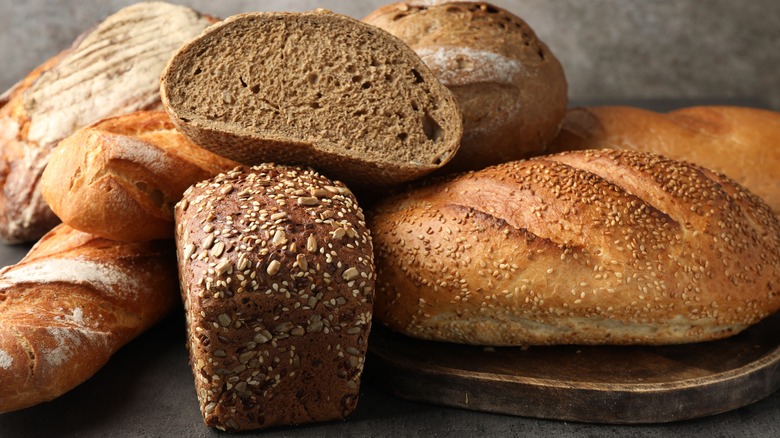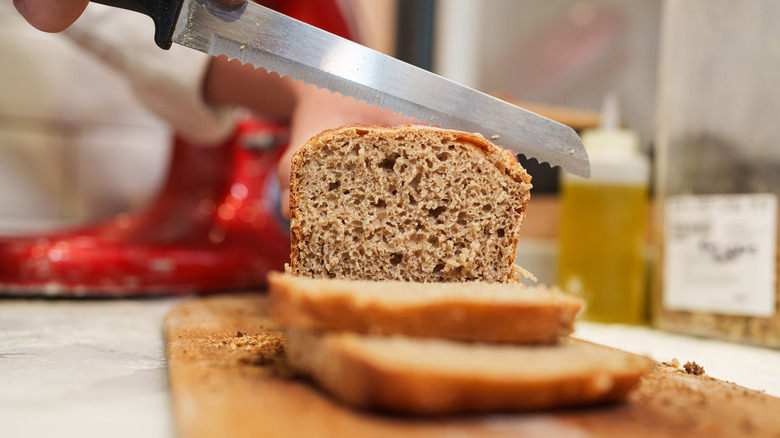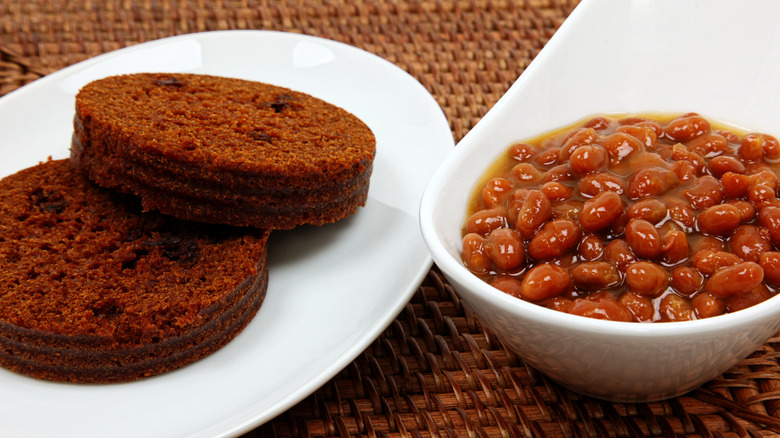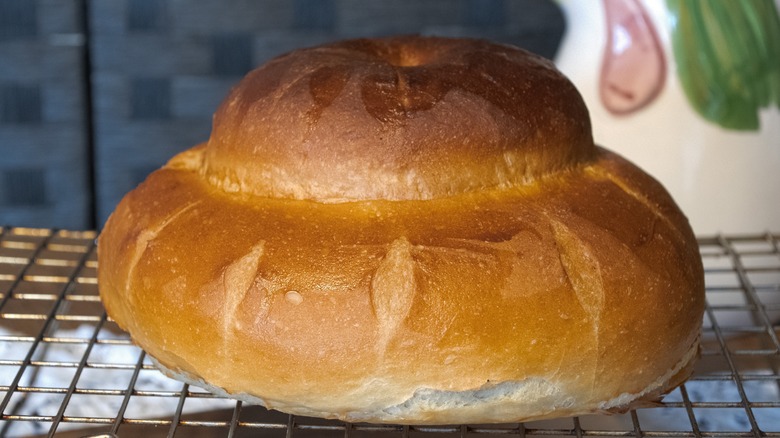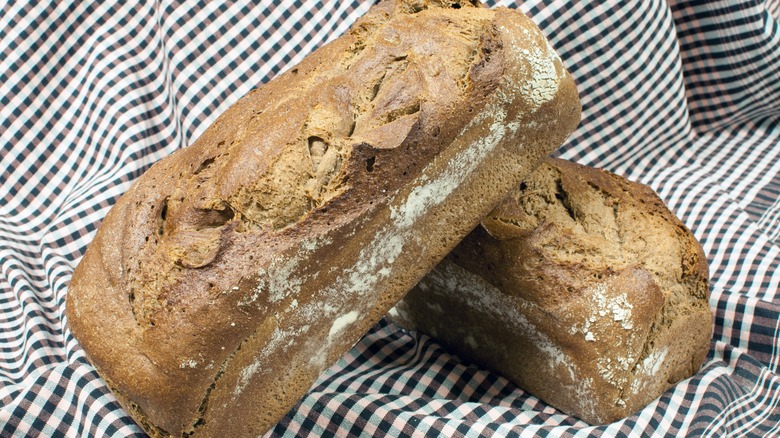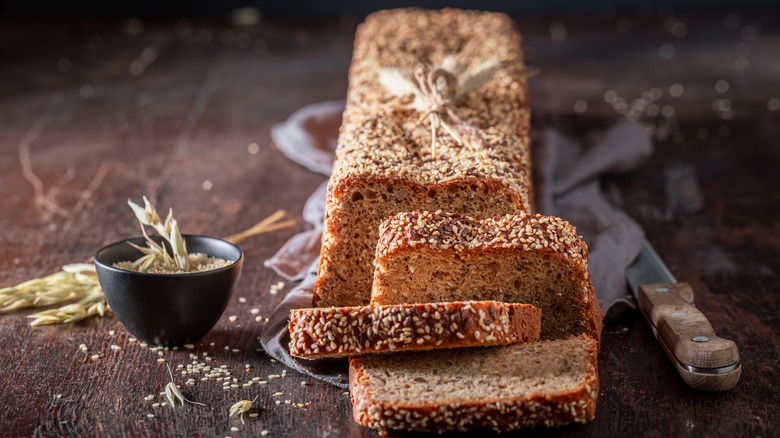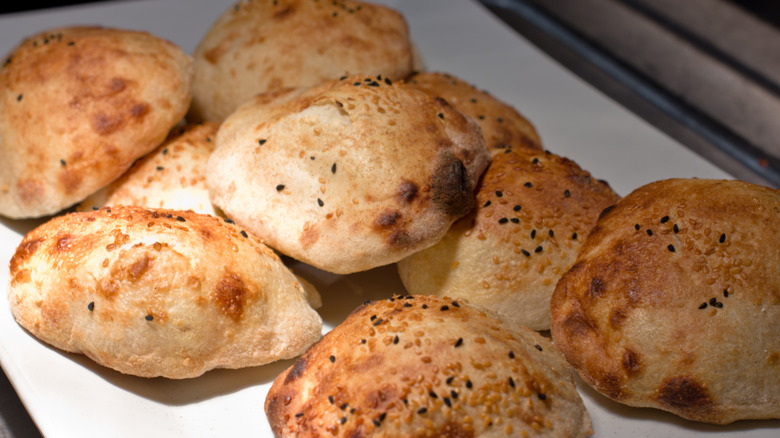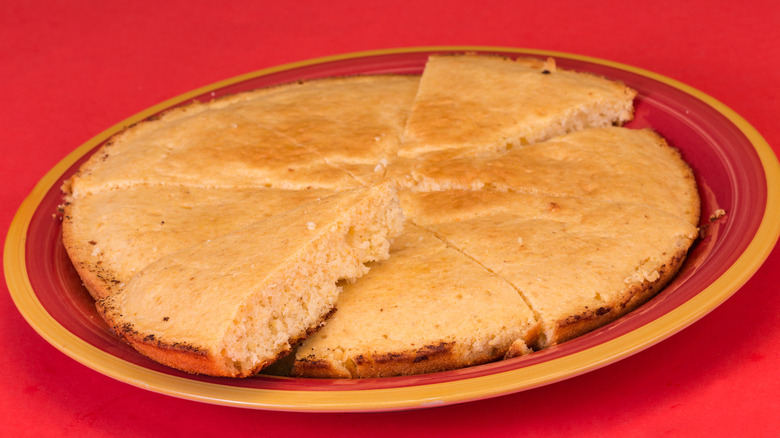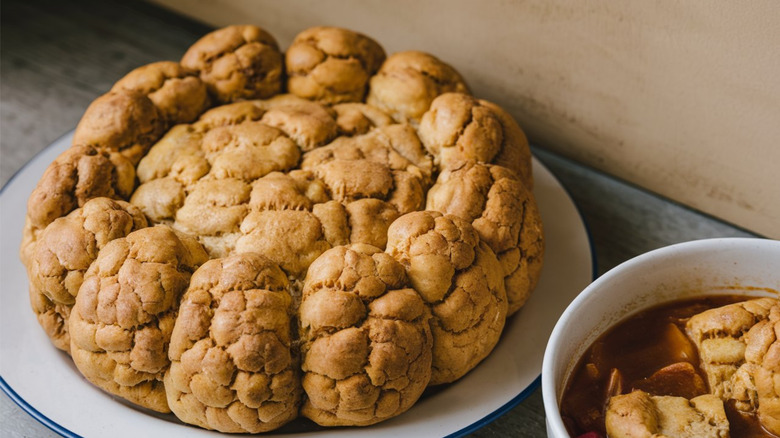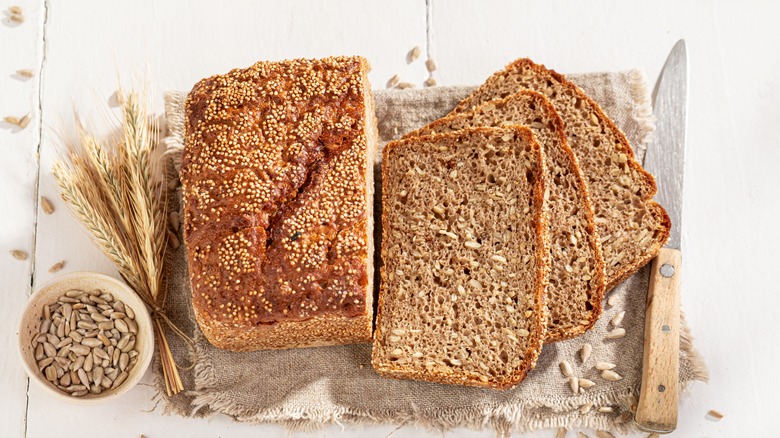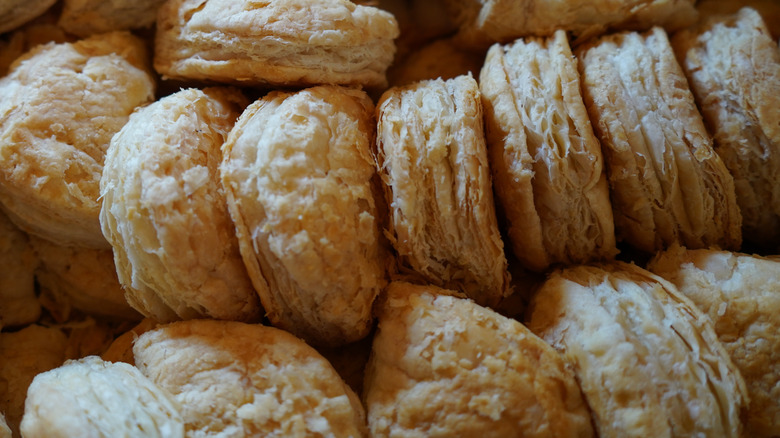Old-School Breads Most People Don't Bake Anymore
Walk into a bakery today and you'll see shelves lined with sourdough boules, crusty baguettes, and maybe a focaccia or two. But for much of history, bread wasn't about Instagram-worthy crusts or specialty flours. Instead, it reflected regional traditions and local ingredients, producing a staple that everybody needed. Across America and beyond, there were countless types of old-school breads most people don't bake anymore.
Some of these breads were tied to immigrant communities who brought recipes from abroad and adapted them to new ingredients. Others were born of necessity, using creative ways to stretch scarce resources or make do with what was at hand. They may not be common now, but each carries a story about how people lived, cooked, and fed their families.
What makes these old-school breads fascinating isn't just how they taste, though many are delicious, but how they reflect the ingenuity of past bakers. Molasses instead of sugar, cornmeal mixed with wheat, steaming instead of baking — the ingredients and techniques tradition and available resources. People might not often make these vintage breads anymore, but we'd love to bring some of them back.
Anadama bread
Anadama bread is a New England staple with a name as unusual as its taste. The loaf is made using a mix of wheat flour and cornmeal, and contains molasses, making it sweeter than your average loaf. It has a texture similar to a regular wheat loaf, rather than a crumbly cornbread.
Local lore suggests the bread was born from a fisherman's disgruntled mutterings about his wife, Anna, who supposedly left him with nothing but cornmeal porridge and molasses to eat. Out of frustration, he combined them with flour and yeast, and the name "Anna, damn her" eventually shortened to "Anadama." Whether or not the tale is true, the bread became a staple in coastal New England.
The cornmeal brings a rustic chew, while the molasses adds both sweetness and a hint of bitterness, giving the bread a complexity missing from plainer white loaves. It's not difficult to make — a straightforward yeast dough enriched by a cornmeal mush — but it tastes amazing.
Anadama bread is a beloved New England breakfast food that's rarely seen outside of regional bakeries today. However, it's a reminder of how parts of America can have their own distinct food traditions that are practically unheard of a hundred miles away.
Boston brown bread
Boston brown bread is another New England classic, but unlike Anadama, it skips the oven entirely. Also known as canned bread, this loaf is steamed rather than baked, producing a moist crumb. Made with wheat, rye, or cornmeal (or a combination), and sweetened with molasses, it's dense, dark, and distinctly flavored, with an earthiness that pairs beautifully with sharp cheeses or baked beans.
The bread has deep roots in New England cooking, perhaps dating back to the 1700s. Practicality drove the cooking method. Steaming allowed families without reliable ovens to prepare bread using simple equipment: a metal can or pudding mold set in boiling water. Back then, it wasn't a given that an average home would have its own oven. People often took dough to the baker in their settlement to be cooked.
Today, Boston brown bread is an oddity. It's sometimes spotted in canned form in grocery stores, but rarely made at home. Steaming bread feels unusual to modern bakers, but the method gives you a flavor and texture worth revisiting. Moist, hearty, and unapologetically old-fashioned, it's an odd type of bread but one we hope doesn't get totally lost to time.
Cottage loaf
A cottage loaf is an old-school British bread that you rarely see around anymore — even in the U.K. It essentially looks like two round loaves stacked on top of one another, the smaller one on top like a snowman. Once a common sight in village bakeries and fresh out of ovens in people's homes, it's now seen as a bit of a faff to make. Plus tastes have changed with many preferring chewy sourdough over soft loaves.
Made from a simple yeast dough of white or mixed white and wholemeal flour, the cottage loaf requires a little extra attention because of its shape. Bakers make a larger ball of dough as the base and a smaller top, attach them carefully, and let the combined dough rise so the two rounds bake as one. The neck between the rounds can underbake, so the loaf needs to be scored and it's important that it spends long enough in the oven.
The cottage loaf's decline began with mechanized baking. Bread that's baked in factories usually has a simple loaf shape that's easy to produce and stack, rather than a complicated form. That decline left the cottage loaf in the hands of craft bakers and enthusiastic home cooks who appreciate its charm. But it's not the trendiest of loaves these days, so it's rarely baked anymore.
Salt-rising bread
Salt-rising bread is a curious, old-fashioned loaf that relies on bacteria rather than commercial yeast for leavening. When baked, the bread has a dense, moist crumb and a strong, savory aroma. Despite the name, salt has nothing to do with how it rises. It actually uses a starter made from potatoes, incubated in a consistently warm spot until the right microbes establish themselves.
The technique demands careful temperature control because the bacteria that do the work prefer warmth rather than cool fermentation. Historically, that meant keeping the starter near a hearth or in a warm box. Contemporary bakers sometimes use proofing boxes, pressure cookers, or yogurt makers. Using bacteria to make bread rise might seem odd, but it's not all that different to sourdough, which is leavened with a starter of wild yeast.
The finished loaf is not airy like a sandwich bread; it's substantial, slightly crumbly, and richly flavored, with an earthy, almost cheesy note. Salt-risen breads fell out of favor as commercial yeast made baking faster and more reliable, but it survives among historians and enthusiasts who enjoy the unusual fermentation process. It's not something that you can whip up in a few hours, so we can see why it fell out of fashion, but it's an interesting method that most folks don't know about.
Graham bread
Graham bread is named after Sylvester Graham, a 19th-century American dietary reformer who promoted whole grains and also invented the Graham cracker. Graham decried refined white flour and championed coarsely ground wheat, also known as graham flour, as a healthier alternative. His ideas helped popularize a family of whole-grain products meant to be filling and virtuous rather than delicate.
The loaf itself is straightforward: graham flour mixed with water or milk, yeast, and occasionally a bit of sweetener or fat to make the crumb more tender. The coarser grind gives the dough a toothier texture and a nutty, robust flavor that differs from finer modern whole-wheat breads. Because the flour carries more bran and germ, the result is hearty.
Graham's movement was as much moralizing as culinary, but it left a lasting footprint — Graham crackers are the most famous example. Today, you won't find many people baking Graham bread. It has well and truly fallen out of fashion. But, sliced warm with butter, or served with soup or cheeses, it's a great old-fashioned whole-grain loaf that shouldn't be entirely left in the past.
Ash cakes
Some breads are made out of necessity, and ash cakes fit that brief. They're made using a basic bread dough, cooked directly in embers or on a hot hearthstone. No pan or oven required. The dough is shaped into flat rounds, pressed slightly, and buried in hot coals or nestled on a flat stone near the flames until a thin crust forms.
Ash cakes were pragmatic. They were often made by soldiers on the move with minimal rations and no specialist equipment. The idea wasn't necessarily to make the best bread ever, but to make something. They do have their benefits, though. The direct heat from the embers gives them a smoky, slightly charred flavor you don't get from oven-baked loaves.
Cooking in embers is fiddly and largely impractical these days, which explains why ash cakes faded from everyday diets. As ovens started to be found in most homes and soldiers were given more reliable rations, there was little need for them. These days, ash cakes survive as a historic curiosity or as a camping treat for anyone who likes cooking with fire. If you make them now, expect a rustic result.
Corn pone
Corn pone is an old-fashioned Southern recipe that comes in various forms. It's the kind of recipe that everyone might have made slightly differently back in the day. However, it's always a type of sweetened cornbread — and in all of its variations, it's largely fallen out of favor.
Some versions are baked as a large loaf in a Dutch oven, with a yeasted dough made from cornmeal and all-purpose flour sweetened with molasses. Other types of corn pone are more like cornmeal pancakes, fried up in a skillet until crispy. There's no absolute right or wrong here, it's all about what the baker is aiming for.
Regardless of the recipe, corn pone isn't something that most people bake anymore. Cornbread is still popular, but most people prefer to stick with classic cornbread recipes rather than branching out into pone territory. This makes sense, considering that cornbread is so easy to make from a mix. We can see why people might have stopped making this old-fashioned alternative.
Bannocks
Bannocks are a family of quick breads, leavened with baking powder, that originated in Scotland. Traditionally made from oat and wheat flours, bannocks were formed into rounds and cooked on a stone in the hearth known as a bannock — hence the name. They're often referred to as flatbreads, but they're not flat like naan or pita bread. Roughly an inch or two thick, they're somewhere between a flatbread and a taller soda bread.
What complicates the story is how this type of bread traveled. Scottish bannocks came over with colonists to the Americas. As a result, an alternative type of bannock started to be made by Indigenous peoples, blending their own cultures' traditional flatbreads and fry breads with British bannocks.
Modern baking trends haven't been kind to quick griddle breads. With supermarket loaves and the sourdough revival, this simple flatbread looks plain by comparison. As a result, it's not the kind of bread that many people make anymore. Sure, there are still folks who make bannocks as a throwback to their own culinary heritage, but it's not an everyday kind of bread. It might be hearty and quick to make, but it's unlikely you'll find one in your local bakery any time soon.
War bread
As the name suggests, war bread is a wartime recipe that harks back to years of rationing. During World Wars I and II, governments encouraged households to stretch scarce wheat by mixing in alternative flours. Since corn grows abundantly in America, war bread recipes in the U.S. usually included cornmeal alongside regular wheat flour. Rye flour was another common addition.
The "recipe" for war bread was less about exact proportions and more about making do. Pamphlets and home economics classes taught cooks to swap, test, and accept slightly different textures. Using a mix of cornmeal, rye flour, and wheat flour, you get a denser bread than you do from wheat flour alone, in part due to the lower gluten content.
War bread fell out of favor once wheat supplies stabilized and white loaves returned as the norm. But, people still remember these recipes from the past. And, these days, alternative flours like rye are fashionable rather than frugal. Today, bakers revisiting war bread treat it less as austerity and more as a practical, flavorful whole-grain loaf. It seems necessity can yield surprisingly good, robust bread.
Rowies
Rowies — also known as butteries — are flaky, buttery hand breads born in the northeast of Scotland, especially around Aberdeen. It's said that they were invented because sailors in the area needed filling food that didn't take up too much space. They sit somewhere between a roll and a pastry, and consist of layers of dough folded with butter, in a kind of salty croissant with less lamination. You probably don't have to guess where the name "buttery" came from.
Traditionally, rowies were made by working strong flour with lard and butter, performing simple folds to create layers, adding more butter, much like making puff pastry or Danish pastry. The dough is richer than everyday bread but less fussy than croissant dough, made with a quick fold rather than the multiple folds a fully laminated pastry requires. They developed as a regional specialty where high-calorie, hand-held baked goods were practical for long days at sea or in the fields.
Rowies remain a regional favorite but rarely feature outside their home turf. Modern tastes veer toward sourdough loaves and baguettes, so these regional specialties sit quietly in local bakeries rather than on national menus. When you find one, expect a slightly crisp exterior, soft interior layers, and a delicious savory-sweet balance. They're great with butter, jam, or more elaborate fillings.
Amish friendship bread
Amish friendship bread is less a single recipe and more like a chain letter in bread form. The process begins with a sourdough-like starter that you feed for several days. After a prescribed number of feedings, it's divided into portions. One portion stays with you to bake with and continue feeding, and the other portions are shared with friends who then continue the process. After the set period, they turn the starter into a bread.
The origins are a bit murky. The practice spread in North American communities in the 20th century, often tied to Amish or Mennonite households but also adopted widely beyond them. The appeal is social as much as culinary. It's a way to connect people through a living piece of food culture. The tradition endures because it's simple to join and fun to share. You receive a jar, you feed it, you bake from it, and you give parts away.
Often, the resulting bread is sweet and spiced, with dried fruit or nuts stirred through. However, you could choose to make a plainer loaf using the same starter. It likely fell out of favor because folks were sick of being given a "gift" that they had to take care of and burden other people with. But given the popularity of sourdough, maybe it's time for it to come back around.
Hoe cakes
Hoe cakes blur the line between bread and pancake, yet for much of American history, they were an everyday staple. Sometimes called johnnycakes, these rustic rounds are made from cornmeal, water, and a little fat, cooked on a hot surface until crisp at the edges. Their name is said to come from the practice of cooking them on the flat side of a garden hoe over an open fire, though in truth most cooks probably used a griddle or cast-iron skillet.
They have a long history. They were originally made by Native Americans and subsequently popular among enslaved people who would likely only have had basic cooking facilities, so often made foods that could be cooked over a fire rather than in an oven. George Washington was said to enjoy them for breakfast and would have had enslaved people cooking in his kitchen, which perhaps explains how they ended up on his table. Unlike fluffy yeast breads, hoe cakes are dense and hearty, with a coarse crumb that soaks up butter, gravy, or syrup.
By the 20th century, they had largely fallen out of everyday use as wheat flour became cheaper and soft sandwich loaves grew in popularity. The abolition of slavery in 1865 eventually led to better living conditions for formerly enslaved people, meaning more traditional oven-baked breads came into fashion. Not many people make hoe cakes these days, but they never fully disappeared.
